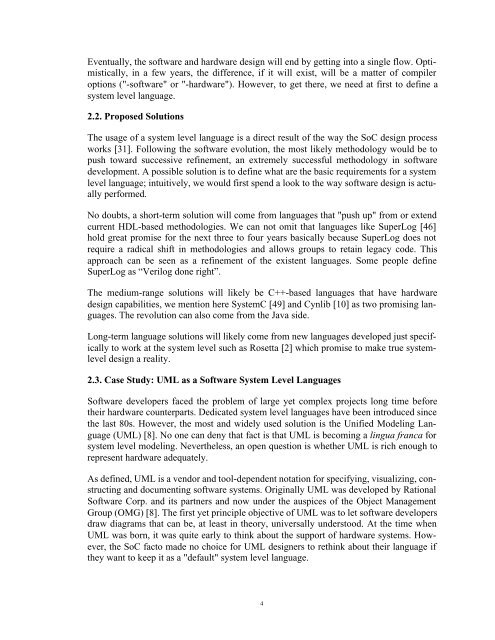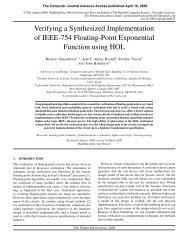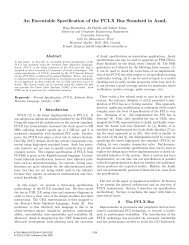PDF File - Hardware Verification Group - Concordia University
PDF File - Hardware Verification Group - Concordia University
PDF File - Hardware Verification Group - Concordia University
Create successful ePaper yourself
Turn your PDF publications into a flip-book with our unique Google optimized e-Paper software.
Eventually, the software and hardware design will end by getting into a single flow. Optimistically,<br />
in a few years, the difference, if it will exist, will be a matter of compiler<br />
options ("-software" or "-hardware"). However, to get there, we need at first to define a<br />
system level language.<br />
2.2. Proposed Solutions<br />
The usage of a system level language is a direct result of the way the SoC design process<br />
works [31]. Following the software evolution, the most likely methodology would be to<br />
push toward successive refinement, an extremely successful methodology in software<br />
development. A possible solution is to define what are the basic requirements for a system<br />
level language; intuitively, we would first spend a look to the way software design is actually<br />
performed.<br />
No doubts, a short-term solution will come from languages that "push up" from or extend<br />
current HDL-based methodologies. We can not omit that languages like SuperLog [46]<br />
hold great promise for the next three to four years basically because SuperLog does not<br />
require a radical shift in methodologies and allows groups to retain legacy code. This<br />
approach can be seen as a refinement of the existent languages. Some people define<br />
SuperLog as “Verilog done right”.<br />
The medium-range solutions will likely be C++-based languages that have hardware<br />
design capabilities, we mention here SystemC [49] and Cynlib [10] as two promising languages.<br />
The revolution can also come from the Java side.<br />
Long-term language solutions will likely come from new languages developed just specifically<br />
to work at the system level such as Rosetta [2] which promise to make true systemlevel<br />
design a reality.<br />
2.3. Case Study: UML as a Software System Level Languages<br />
Software developers faced the problem of large yet complex projects long time before<br />
their hardware counterparts. Dedicated system level languages have been introduced since<br />
the last 80s. However, the most and widely used solution is the Unified Modeling Language<br />
(UML) [8]. No one can deny that fact is that UML is becoming a lingua franca for<br />
system level modeling. Nevertheless, an open question is whether UML is rich enough to<br />
represent hardware adequately.<br />
As defined, UML is a vendor and tool-dependent notation for specifying, visualizing, constructing<br />
and documenting software systems. Originally UML was developed by Rational<br />
Software Corp. and its partners and now under the auspices of the Object Management<br />
<strong>Group</strong> (OMG) [8]. The first yet principle objective of UML was to let software developers<br />
draw diagrams that can be, at least in theory, universally understood. At the time when<br />
UML was born, it was quite early to think about the support of hardware systems. However,<br />
the SoC facto made no choice for UML designers to rethink about their language if<br />
they want to keep it as a "default" system level language.<br />
4





